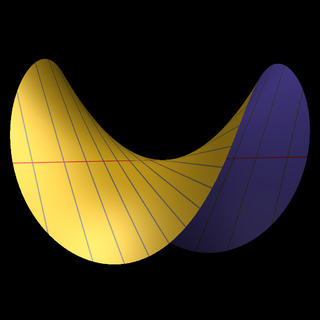
In mathematics, a direct limit is a way to construct a object from many objects that are put together in a specific way. These objects may be groups, rings, vector spaces or in general objects from any category. The way they are put together is specified by a system of homomorphisms between those smaller objects. The direct limit of the objects , where ranges over some directed set , is denoted by .
In mathematics, K-theory is, roughly speaking, the study of a ring generated by vector bundles over a topological space or scheme. In algebraic topology, it is a cohomology theory known as topological K-theory. In algebra and algebraic geometry, it is referred to as algebraic K-theory. It is also a fundamental tool in the field of operator algebras. It can be seen as the study of certain kinds of invariants of large matrices.

In algebraic geometry, a projective variety over an algebraically closed field k is a subset of some projective n-space over k that is the zero-locus of some finite family of homogeneous polynomials of n + 1 variables with coefficients in k, that generate a prime ideal, the defining ideal of the variety. Equivalently, an algebraic variety is projective if it can be embedded as a Zariski closed subvariety of .

In mathematics, birational geometry is a field of algebraic geometry in which the goal is to determine when two algebraic varieties are isomorphic outside lower-dimensional subsets. This amounts to studying mappings that are given by rational functions rather than polynomials; the map may fail to be defined where the rational functions have poles.
In mathematics, a Cohen–Macaulay ring is a commutative ring with some of the algebro-geometric properties of a smooth variety, such as local equidimensionality. Under mild assumptions, a local ring is Cohen–Macaulay exactly when it is a finitely generated free module over a regular local subring. Cohen–Macaulay rings play a central role in commutative algebra: they form a very broad class, and yet they are well understood in many ways.
In algebraic geometry, divisors are a generalization of codimension-1 subvarieties of algebraic varieties. Two different generalizations are in common use, Cartier divisors and Weil divisors. Both are derived from the notion of divisibility in the integers and algebraic number fields.

In mathematics, blowing up or blowup is a type of geometric transformation which replaces a subspace of a given space with all the directions pointing out of that subspace. For example, the blowup of a point in a plane replaces the point with the projectivized tangent space at that point. The metaphor is that of zooming in on a photograph to enlarge part of the picture, rather than referring to an explosion.
In algebraic geometry, an algebraic variety or scheme X is normal if it is normal at every point, meaning that the local ring at the point is an integrally closed domain. An affine variety X is normal if and only if the ring O(X) of regular functions on X is an integrally closed domain. A variety X over a field is normal if and only if every finite birational morphism from any variety Y to X is an isomorphism.
In mathematics, in particular the subfield of algebraic geometry, a rational map or rational mapping is a kind of partial function between algebraic varieties. This article uses the convention that varieties are irreducible.
In algebraic geometry, the geometric genus is a basic birational invariant pg of algebraic varieties and complex manifolds.
In algebraic geometry, the Chow groups of an algebraic variety over any field are algebro-geometric analogs of the homology of a topological space. The elements of the Chow group are formed out of subvarieties in a similar way to how simplicial or cellular homology groups are formed out of subcomplexes. When the variety is smooth, the Chow groups can be interpreted as cohomology groups and have a multiplication called the intersection product. The Chow groups carry rich information about an algebraic variety, and they are correspondingly hard to compute in general.
In commutative algebra, an element b of a commutative ring B is said to be integral overA, a subring of B, if there are n ≥ 1 and aj in A such that
In algebraic geometry, the Iitaka dimension of a line bundle L on an algebraic variety X is the dimension of the image of the rational map to projective space determined by L. This is 1 less than the dimension of the section ring of L
In mathematics, specifically algebraic geometry, an exceptional divisor for a regular map
In mathematics, the cone of curves of an algebraic variety is a combinatorial invariant of importance to the birational geometry of .
In algebraic geometry, the minimal model program is part of the birational classification of algebraic varieties. Its goal is to construct a birational model of any complex projective variety which is as simple as possible. The subject has its origins in the classical birational geometry of surfaces studied by the Italian school, and is currently an active research area within algebraic geometry.
In mathematics, canonical singularities appear as singularities of the canonical model of a projective variety, and terminal singularities are special cases that appear as singularities of minimal models. They were introduced by Reid (1980). Terminal singularities are important in the minimal model program because smooth minimal models do not always exist, and thus one must allow certain singularities, namely the terminal singularities.
This is a glossary of algebraic geometry.
In mathematics, derived noncommutative algebraic geometry, the derived version of noncommutative algebraic geometry, is the geometric study of derived categories and related constructions of triangulated categories using categorical tools. Some basic examples include the bounded derived category of coherent sheaves on a smooth variety, , called its derived category, or the derived category of perfect complexes on an algebraic variety, denoted . For instance, the derived category of coherent sheaves on a smooth projective variety can be used as an invariant of the underlying variety for many cases. Unfortunately, studying derived categories as geometric objects of themselves does not have a standardized name.
In mathematics, and in particular algebraic geometry, K-stability is an algebro-geometric stability condition for projective algebraic varieties and complex manifolds. K-stability is of particular importance for the case of Fano varieties, where it is the correct stability condition to allow the formation of moduli spaces, and where it precisely characterises the existence of Kähler–Einstein metrics.
































